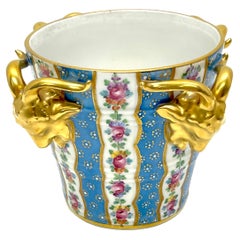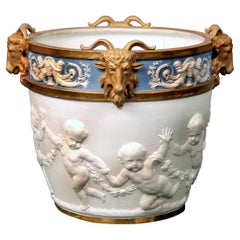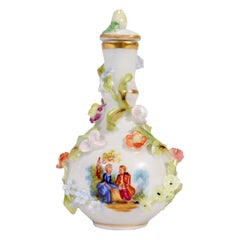Dresden Porcelain Planters, Cachepots and Jardinières
Dresden porcelain, as a term, is the subject of some confusion. In some contexts, it refers to the hard-paste ceramic wares produced by the workshops that sprang up in and around the Saxon capital in the 19th century. In others, it denotes only the output of one of these, Sächsische Porzellanmanufaktur Dresden, known in English as simply Dresden Porcelain, which was established in 1872 in the city of Freital, Saxony.
Complicating matters further, early publications about porcelain often used “Dresden” and “Meissen” interchangeably. It is true that the cities of Dresden and Meissen are connected through their long, shared history of decorative arts production and, in fact, most Meissen porcelain was sold in Dresden, the artistic and cultural center of Saxony.
However, Meissen is the site of the factory that produced the first European porcelain, at the turn of the 18th century, while Dresden did not come into prominence until the mid-19th century, during the high point of the Rococo revival. (Porcelain originated in China, which is why many collectors still seek out what they call "Dresden china.")
And while Meissen is known for manufacturing porcelain, from clay models through finished product, Dresden is celebrated for its decorating studios, of which there were several dozen in and around the city during the 19th century. Their skilled painters often used “blanks” from Meissen as their canvases. So a piece of Dresden porcelain may have been formed and fired at Meissen, painted in Dresden, and ultimately sold in one of that city’s shops.
The figurines, plates and vases produced during the 19th century via this complex process remain appealing to this day, their bright hues and pastoral imagery typical of the Rococo revival, which brought scrollwork, shells, foliage, flowers and fruit back into vogue after decades of restrained neoclassicism and austere Gothic Revival design. Dresden figurines, which like their Meissen counterparts were inspired by the characters of the Commedia dell'Arte, have a witty, cheerful quality that has been likened to that of scenes painted by Watteau and Fragonard.
Before its near-total destruction during World War II, Dresden was home to more than 200 painting studios.
The Dresden style, however, is associated with wares bearing the blue crown mark (Meissen’s mark is a pair of cobalt blue crossed swords), which was first registered in 1883 by Richard Klemm, Donath & Co, Oswald Lorenz, and Adolph Hamann. Prominent painters from this period include Helena Wolfsohn, Franziska Hirsch, Ambrosius Lamm — whose skill in the application of metallic or lustre paints is on lavish display in this dinner service from the 1920s — and Carl Thieme, a master in floral painting, as demonstrated by his decoration on this circa 1901 ram’s head urn.
Dresden painters also used a decorative technique known as “Dresden lace.” This involved dipping real lace into liquid porcelain and applying it to a figure, which was then fired in a kiln. The fabric would burn away, leaving a fragile, crinoline-like shell — the type of delicate and whimsical detail that characterizes Dresden porcelain, one of Europe’s great ceramic traditions.
Find authentic antique Dresden porcelain on 1stDibs.
Early 20th Century German Louis XVI Dresden Porcelain Planters, Cachepots and Jardinières
Porcelain
Late 19th Century German Belle Époque Antique Dresden Porcelain Planters, Cachepots and Jardinières
Porcelain
20th Century German Rococo Dresden Porcelain Planters, Cachepots and Jardinières
Porcelain
Early 1900s Japanese Antique Dresden Porcelain Planters, Cachepots and Jardinières
Brass, Enamel
Early 20th Century German British Colonial Dresden Porcelain Planters, Cachepots and Jardinières
Porcelain
19th Century French Art Nouveau Antique Dresden Porcelain Planters, Cachepots and Jardinières
Majolica, Porcelain
Early 19th Century English Neoclassical Revival Antique Dresden Porcelain Planters, Cachepots and Jardinières
Porcelain
Early 20th Century German Art Nouveau Dresden Porcelain Planters, Cachepots and Jardinières
Porcelain
20th Century German Rococo Dresden Porcelain Planters, Cachepots and Jardinières
Porcelain
19th Century French Louis XVI Antique Dresden Porcelain Planters, Cachepots and Jardinières
Sterling Silver
Late 19th Century Louis XVI Antique Dresden Porcelain Planters, Cachepots and Jardinières
Porcelain
19th Century French Chinoiserie Antique Dresden Porcelain Planters, Cachepots and Jardinières
Ormolu
Late 19th Century French Louis XVI Antique Dresden Porcelain Planters, Cachepots and Jardinières
Bronze, Enamel
19th Century Chinese Qing Antique Dresden Porcelain Planters, Cachepots and Jardinières
Porcelain
Dresden Porcelain planters, cachepots and jardinières for sale on 1stDibs.
- 1stDibs ExpertApril 22, 2024The famous porcelain from Dresden is usually just referred to as Dresden porcelain. However, its maker is Sächsische Porzellan-Manufaktur Dresden GmbH, which translates to Saxon Porcelain Manufactory in Dresden Ltd. The company opened in Potschappel, a suburb of Freital in the Sächsische Schweiz-Osterzgebirge district of Dresden, in 1872. Find a variety of Dresden porcelain on 1stDibs.
- 1stDibs ExpertMay 3, 2024The history of Dresden Porcelain began with the founding of Sächsische Porzellanmanufaktur Dresden by Carl-Johann Gottlob Thieme in 1872 in the city of Freital, Saxony. During the decades that followed, his son-in-law Carl August Kuntzsch joined the company and pioneered the process of adding ornate floral ornamentation to porcelain. When Thieme died in 1912, Kuntzsch took up the reins of Dresden Porcelain. The company saw a decline during World War I and II. During the period after the Second World War, the Soviet Union gradually assumed control of Dresden Porcelain, renaming it VEB Sächsische Porzellan-Manufaktur Dresden. The reunification of Germany in 1990 allowed the company to return to private ownership. A French investor group purchased it in 1991 and then sold it to the Dresden IPV group, led by art patron Jürgen Wegener, in 1993. Gunther Seifert and Klaus-Peter Arnold bought out the group following its bankruptcy in 1998, only to resell it to Geschwister Hillebrand GmbH in 2005. Explore a selection of Dresden Porcelain on 1stDibs.



